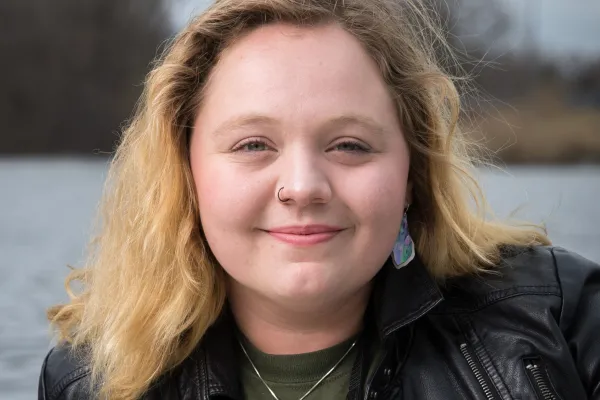Karli Hakala ’19: Tracking Wildlife in the Field
Campus Life

Published April 22, 2019
One day in March, Karli Hakala ’19 was treated to a rare sight: She managed to “camera trap” a bobcat in Amherst during a wildlife identification class she is taking at the University of Massachusetts.
“I was looking for the best place to put my camera—where I thought it would catch the most pictures,” Hakala explains, pulling up the shot on her cell phone. “I used scat and pawprints to decide on a tree that looked like a very active place. I was surprised to go through my pictures and see a bobcat!”
Hakala, who will be graduating in May with a degree in biological sciences, did not come to Smith knowing wildlife science would be her calling. She started out planning to major in engineering but decided in her first year that the subject wasn’t the right fit for her.
“I thought about the things that really bring me joy and things I would do every day even if I wasn’t getting paid, and wildlife management kind of found me,” says Hakala, whose hometown is Frostburg, Maryland.
Her realization led to a search for internships that could inspire her. The summer after her sophomore year, Hakala came across an opportunity to work as a wildlife technician with the Army Corp of Engineers in Riverdale, North Dakota.
“It was a transformative experience,” she says. “I worked with endangered birds and realized it was what I wanted to work towards with my academics.”
When she returned to campus, Hakala approached Marney Pratt, a lab instructor in the biological sciences department, for advice about how to pursue wildlife field work during her time at Smith. Pratt took Hakala on as a special studies student.
“I think that was one of the most pivotal moments in my Smith career,” Hakala says. “I was a little nervous because I had only recently switched into the biology major. But Marney saw something in me and thought I could do it.”
In addition to a special studies class on the spread of invasive insects in hemlock trees, Hakala began working in Pratt’s lab on the same research topic. She served as a teaching assistant in Pratt’s classes, where she discovered a community of peers interested in similar research.
Hakala is upbeat about the many opportunities Smith has provided her.
“I’ve taken some great classes in the biology department and in the UMass natural resource department,” she says. “The Five College Consortium, in general, has been a great resource for me.”
After graduation, Hakala hopes the rewarding field experience she had photographing the bobcat will continue as she begins a job with the National Park Service. She’ll be tracking endangered birds as a wildlife technician on Assateague Island in Maryland and Virginia.
“I’ll find them in my binoculars—find their nest—and keep going back to make sure they are doing okay,” Hakala says. “It’s like a treasure hunt.”